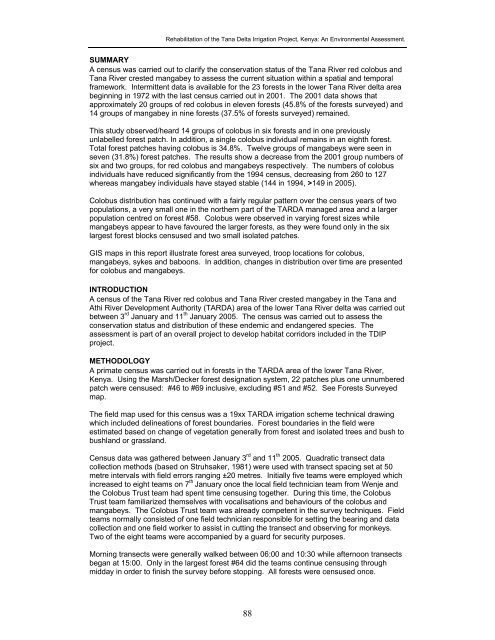Tana Delta Irrigation Project, Kenya: An Environmental Assessment
Tana Delta Irrigation Project, Kenya: An Environmental Assessment
Tana Delta Irrigation Project, Kenya: An Environmental Assessment
Create successful ePaper yourself
Turn your PDF publications into a flip-book with our unique Google optimized e-Paper software.
Rehabilitation of the <strong>Tana</strong> <strong>Delta</strong> <strong>Irrigation</strong> <strong>Project</strong>, <strong>Kenya</strong>: <strong>An</strong> <strong>Environmental</strong> <strong>Assessment</strong>.<br />
SUMMARY<br />
A census was carried out to clarify the conservation status of the <strong>Tana</strong> River red colobus and<br />
<strong>Tana</strong> River crested mangabey to assess the current situation within a spatial and temporal<br />
framework. Intermittent data is available for the 23 forests in the lower <strong>Tana</strong> River delta area<br />
beginning in 1972 with the last census carried out in 2001. The 2001 data shows that<br />
approximately 20 groups of red colobus in eleven forests (45.8% of the forests surveyed) and<br />
14 groups of mangabey in nine forests (37.5% of forests surveyed) remained.<br />
This study observed/heard 14 groups of colobus in six forests and in one previously<br />
unlabelled forest patch. In addition, a single colobus individual remains in an eighth forest.<br />
Total forest patches having colobus is 34.8%. Twelve groups of mangabeys were seen in<br />
seven (31.8%) forest patches. The results show a decrease from the 2001 group numbers of<br />
six and two groups, for red colobus and mangabeys respectively. The numbers of colobus<br />
individuals have reduced significantly from the 1994 census, decreasing from 260 to 127<br />
whereas mangabey individuals have stayed stable (144 in 1994, >149 in 2005).<br />
Colobus distribution has continued with a fairly regular pattern over the census years of two<br />
populations, a very small one in the northern part of the TARDA managed area and a larger<br />
population centred on forest #58. Colobus were observed in varying forest sizes while<br />
mangabeys appear to have favoured the larger forests, as they were found only in the six<br />
largest forest blocks censused and two small isolated patches.<br />
GIS maps in this report illustrate forest area surveyed, troop locations for colobus,<br />
mangabeys, sykes and baboons. In addition, changes in distribution over time are presented<br />
for colobus and mangabeys.<br />
INTRODUCTION<br />
A census of the <strong>Tana</strong> River red colobus and <strong>Tana</strong> River crested mangabey in the <strong>Tana</strong> and<br />
Athi River Development Authority (TARDA) area of the lower <strong>Tana</strong> River delta was carried out<br />
between 3 rd January and 11 th January 2005. The census was carried out to assess the<br />
conservation status and distribution of these endemic and endangered species. The<br />
assessment is part of an overall project to develop habitat corridors included in the TDIP<br />
project.<br />
METHODOLOGY<br />
A primate census was carried out in forests in the TARDA area of the lower <strong>Tana</strong> River,<br />
<strong>Kenya</strong>. Using the Marsh/Decker forest designation system, 22 patches plus one unnumbered<br />
patch were censused: #46 to #69 inclusive, excluding #51 and #52. See Forests Surveyed<br />
map.<br />
The field map used for this census was a 19xx TARDA irrigation scheme technical drawing<br />
which included delineations of forest boundaries. Forest boundaries in the field were<br />
estimated based on change of vegetation generally from forest and isolated trees and bush to<br />
bushland or grassland.<br />
Census data was gathered between January 3 rd and 11 th 2005. Quadratic transect data<br />
collection methods (based on Struhsaker, 1981) were used with transect spacing set at 50<br />
metre intervals with field errors ranging ±20 metres. Initially five teams were employed which<br />
increased to eight teams on 7 th January once the local field technician team from Wenje and<br />
the Colobus Trust team had spent time censusing together. During this time, the Colobus<br />
Trust team familiarized themselves with vocalisations and behaviours of the colobus and<br />
mangabeys. The Colobus Trust team was already competent in the survey techniques. Field<br />
teams normally consisted of one field technician responsible for setting the bearing and data<br />
collection and one field worker to assist in cutting the transect and observing for monkeys.<br />
Two of the eight teams were accompanied by a guard for security purposes.<br />
Morning transects were generally walked between 06:00 and 10:30 while afternoon transects<br />
began at 15:00. Only in the largest forest #64 did the teams continue censusing through<br />
midday in order to finish the survey before stopping. All forests were censused once.<br />
88

















